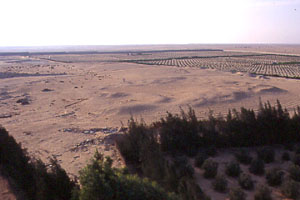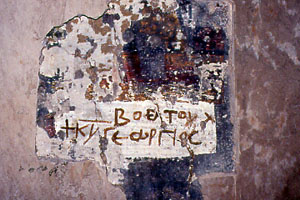|
Currently, there are four active Coptic monasteries
in the Wadi Natrun but there used to be many more. Just north of Deir al-Baramus
(Monastery of the Romans) the remains of another monastery, probably
Deir Anba Mussa al-Aswad (Monastery of Moses the Black), can be seen
under the sand:
|
|
In the church of Deir al-Surian (Monastery
of the Syrians), about 15 km. east of Deir al-Baramus and just south of
Deir Anba Bishoi (Monastery of Saint Pschoi), early wall paintings
have been plastered over, obscuring them from view for centuries until numerous
windows were opened to bring them to light once again:
|
|
|
|
|

|
|

|
|
|
|
|
|
|
|
|
Objective of visit:
|
|
To draw maps and plans of Deir Anba Mussa al-Aswad,
just north of Deir al-Baramus, and participate in the excavation of that site
as well as the exploration and research of the wall-paitings in Deir al-Surian. |
|
Date of visit:
|
|
Fall 1994 and fall 1995. |
|
Fellow visitors:
|
|
Karel Innemée, Mat Immerzeel and (in 1995)
Ewa Parandowska, Sigrid van Roode and Carolien van Zoest. |
| Results: |
|
Some of the results of this project have been published
in the April 1995 issue of Egypt Today, pages 130 and 131; in Egyptian
Archaeology 1999; 15: 41-43; and in the Journal of Syriac Studies
2000; 3: number 2. |
| Approximate position and
date of the site: |
|
The Wadi Natrun (also known as Scetis) is located
just west of the Nile Delta, about half-way between Cairo and Alexandria.
The name refers to the natron salts that can be found here and which were
used in Pharaonic times for the mummification of the dead. Along with the
Eastern Desert,
where the Monasteries of Saint Anthony and Saint Paul are still active today,
the Wadi Natrun was one of the places where early Christian monks retreated
for meditation and contemplation. Deir Anba Mussa al-Aswad was among the first
of many Christian monasteries to be founded here in the 4th century AD. Deir
al-Surian was founded later, in the 6th century AD, after a dispute over
the status of the Virgin Mary divided the monks. Deir al-Baramus may also
date to that period. |
| Short description of the
site: |
|
The Wadi Natrun is a depression in the Western Desert
that has been eroded by a pre-historic branch of the Nile. In the north
there are several salty lakes, which are sometimes completely dry. In the
south there are four active monasteries and the remains of many abandoned
ones. The area has played an important role in the history of the Coptic
church and many patriarchs were chosen from the monks resident here. Deir
al-Baramus is the western-most of the four monasteries in Wadi Natrun and
Deir Anba Mussa al-Aswad is just north of here. This may be the original
monastery in the area. Like these two monasteries, also Deir al-Surian and
Deir Anba Bishoi are located next to each other. Here, however, both monasteries
have remained active until today. The current revival of the Coptic church,
which started in the 1960's, has resulted in a lot of activity in the area
which did not always respect its historic and environmental identity. |
| Additional remarks: |
|
This project was sponsored by the Netherlands Ministry
of Foreign Affairs through the Egyptian-Netherlands Coptic Antiquities Conservation
Project. |
| HOME |
|
|

|
|
|

